#c: guillaume
Explore tagged Tumblr posts
Text

A Scattering of Jades - art by Guillaume Sorel (2006)
#guillaume sorel#fantasy art#horror art#cover art#alexander c. irvine#mystery novels#fantasy novels#le soleil du nouveau monde#fleuve noir#2000s#2006
558 notes
·
View notes
Text

Nature forging a baby.” Guillaume de Lorris and Jean de Meun, Roman de la Rose. Bruges, c.1490-c.1500
32K notes
·
View notes
Text
hot twink is tied up and penetrated


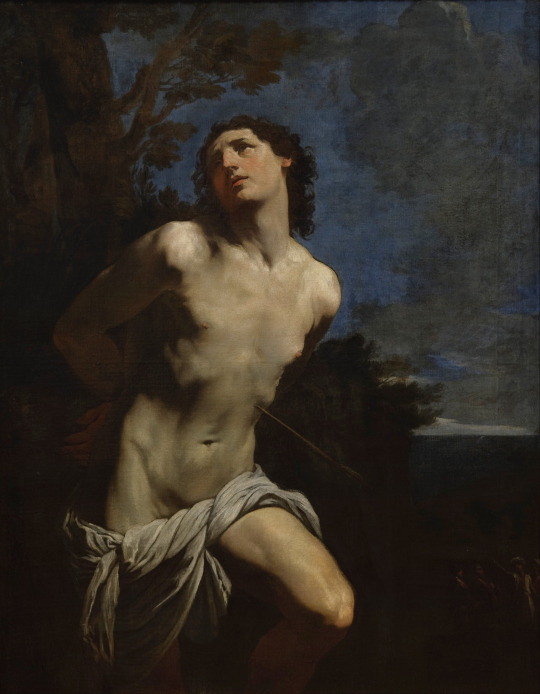





A Collection of Homoerotic Paintings of Saint Sebastian
Carlo Saraceni, c. 1610 /// Nicolas Régnier, c. 1620 /// Guido Reni, c. 1625 /// Nicolas Régnier, c. 1625 /// Louis Finson, c. 1613 /// François-Guillaume Ménageot, c. 1760 /// Guido Reni, c. 1615 /// Nicolas Régnier, c. 1620
#academic writings about saint sebastian are so funny cos they're all like:#'yeah he isn't a very important catholic figure or anything. renaissance artists just really liked painting him. hmmm'#the bottom left one. he doesn't even have any arrows. dude you didn't even try to hide what you were doing#renaissance art#renaissance#baroque#baroque art#saint sebastian#gay#< I hope my gay brothers appreciate this#art#oil painting#catholic art
6K notes
·
View notes
Text
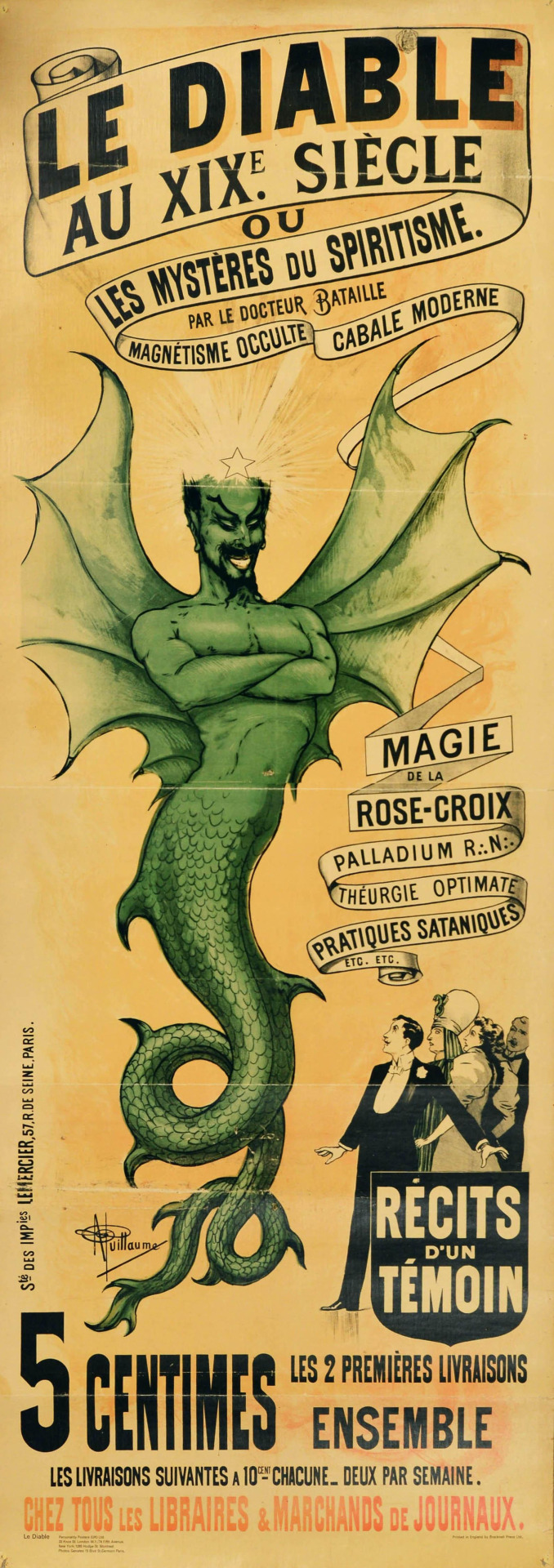
Albert Guillaume (1873–1942) - advertising poster for French magazine “Le Diable au XIXe Siècle”, c. 1890s
#albert guillaume#le diable au XIXe siècle#the devil in the 19th century#19th century art#19th century#fin de siècle#demons#devils#occult#paranormal#horror art#poster art#vintage posters
329 notes
·
View notes
Text
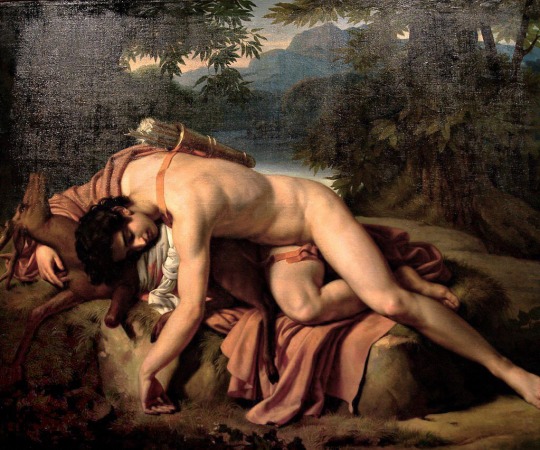
Sébastien Louis Guillaume Norblin de la Gordaine (1796-1884). “Cyparissus dying on the body of his stag”, c.1827. Musée des Beaux-Arts, Orléans, FR. oil on canvas
234 notes
·
View notes
Text

Prosper Lafaye, Pierre Joseph Guillaume Zimmermann in his Apartment in the Square d'Orleans, Paris, c. 1850, oil on canvas.
#prosper lafaye#19th century art#19th century#french art#french artist#art#interior design#interior#period design#painting#oil painting#oil on canvas#paris#france#domestic interior#period interior#musée carnavalet#1850s#second republic#second empire#french interior#window#sitting room
67 notes
·
View notes
Text
Je sais que j'ai mal choisi à chaque début d'avant-première. Je dois être le seul acteur qui préfère jouer que de voir le résultat ! Tu parles de l'armoire à glace qui est là tous les jours sur le plateau ? Vos parents vous ont pas nourris pareil ? Je compte pas te le piquer, j'ai trop peur — mais te piquer toi par exemple c'est envisageable ? Une petite répétition ça fait jamais de mal.

T'as un peu de marge avant qu'on arrive à l'avant-première, ça te laisse le temps de respirer. Mais je pense que t'es pas le seul à pas aimer voir tes films, y'a que les mégalos qui apprécient vraiment se voir. Oui c'est bien lui. Il a raflé tous les gênes d'Hulk et il m'a laissé le reste. Me piquer moi ? Wow, c'est rapide entre nous.

Des astuces pour un apprentissage plus rapide ?
Je comprends pas comment je faisais avant pour que tout rentre aussi facilement dans ma tête. Visiblement, à force de plus pratiquer... j'ai fini par rouiller.

#c#c:kr#ooc: oui donc je t'ai DEMANDÉ#pas forcée#MDRRRRR#alors non je parlais pas de ce gif#mais maintenant que tu en parles...#tu sais que je l'ai montré à guillaume tellement je rigolais
33 notes
·
View notes
Text











"The Search" - a webweave for Room 3 of @mcytblrescape !!
Wild Life sources: clock, "Ohne Titel (Geldig)" by Kurt Schwitters, "Aucassin Seeks for Nicolette" by Maxfield Parrish, "Tamarisk Trees in Early Sunlight" by Guy Rose, window, blue flower, green flower, pink flower, pink flowers, camera, "Starting Fires" by Bears in Trees, "Like Real People Do" by Hozier, "Puppet Loosely Strung" by the Correspondents
Pirates & Rats 2 sources: clock, "Merzzeichnung in Merzzeichnung" by Kurt Schwitters, stamps, books, trinket tin, crystal skull, "14 Verses" by Declan Bennett, "Farewell Wanderlust" by the Amazing Devil, "Gods & Monsters" by Lana del Rey
New Life sources: clock, "20 Ore mit Koranseiten" by Kurt Schwitters, "Snow-Covered Landscape" by Guillaume Vogels, tamagotchi, camera, hat, backpack, "I Could Never Be" from Steven Universe, "Tread on Me" by Matt Maeson
Ultimate Survival SMP sources: clock, "C 50 Last Birds and Flowers" by Kurt Schwitters, "Ceylonese Jungle" by Hermann von Konigsbrunn, bear, beetle, moth, crown, gloves, vined hand, "King" by Lauren Aquilina, "I Just Don't Care That Much" by Matt Maeson
Limited & Secret Life sources: clock, "Spitzbergen Merzzeichnung" by Kurt Schwitters, "She came to the blue sea-ocean" by Ivan Bilibin, bird, letter, fish, cassette, "Queen of Nothing" by the Crane Wives, "What's a Devil to Do" by Harley Poe, "14 Verses" by Declan Bennett, "Bullet" by Saint Motel
Rats sources: clock, "Zeichnung I 9 Hebel 2" by Kurt Schwitters, "Candles" by Gerhard Richter, "Sunflower Seeds" by Ai Weiwei, band-aid tin, bazooka gum, amethyst geode, amethyst crystal, socks, tag, knife, "Puppet Loosely Strung" by the Correspondents, "What's a Devil to Do" by Harley Poe
Double Life sources: clock, "Mz x 21 Street" by Kurt Schwitters, "Loup Scar, Wharfdale" by Richard Jack, coin, coffin, cat in moon, bottle cap, receipt, "Honeybee" by Steam Powered Giraffe, "the broken hearts club" by gnash
Last Life sources: clock, "Merz 30, 42" by Kurt Schwitters, "Trees and Church Tower" by Raymond McIntyre, mask, locket, clover, scarecrow and rabbit, "Whispering Grass" by the Ink Spots, "How to Rest" by the Crane Wives
3rd Life sources: clock, "Sans Titre" by Kurt Schwitters, "Forest and Dove" by Max Ernst, window, heart, pomegranate, stamp, fox, "14 Verses" by Declan Bennett, "Honeybee" by Steam Powered Giraffe
Evo sources: clock, "Ohne Titel" by Kurt Schwitters, "The man with the cart" by Ivan Grohar, pearls, stars, window, feather, dog, "Rule #9 - Child of the Stars" by Fish in a Birdcage, "Dancing After Death" by Matt Maeson
Finale-unique sources: tv, warning window, video player, error tabs, handheld game console, progress bar, axe, "The Circle Maker" by Sparkbird, "The Mask" by Matt Maeson
All skins from namemc; all stereo pngs from this post. As I'm sure you can tell, this is a hell of a source list, so I apologize if I linked anything incorrectly or managed to forget something!
#martyn inthelittlewood#inthelittlewood#webweave#no thoughts tags empty#life series#new life smp#trafficblr#evolution smp#rats smp#rats in paris#pirates smp#ultimate survival smp#datastream defender lore
50 notes
·
View notes
Text

Sébastien Louis Guillaume Norblin de la Gourdaine: Village on the Island of Ischia, c. 1826
#Sébastien Louis Guillaume Norblin de la Gourdaine#landscape#landscape art#mountains#village#1820s#19th century art#art#fine art#painting#art history#*
42 notes
·
View notes
Text
Nigel's Book Details: Spread Four
Using the order in which each spread is presented in the scene where Alex finally reads through Nigel's book, this is the fourth spread.
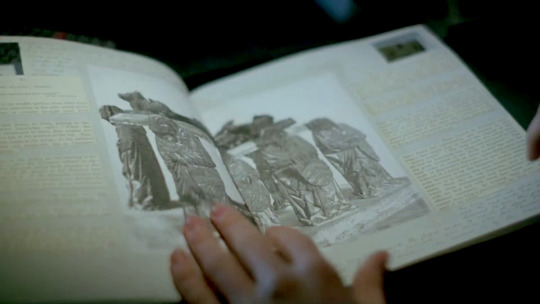
Text
Sadly, this is yet another spread wherein the text excerpts and the handwritten notes remain illegible even with sharpening/image filtering.
Central Image: Tomb of Philippe Pot
This spread is dominated by one large image across both pages. Despite the awkward angle and distortion from running across the gutter between pages, it was actually fairly easy to identify this image with the right search terms.

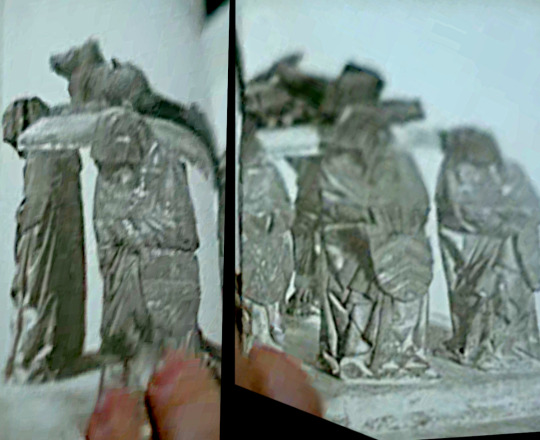
This is an old photograph of the tomb of Philippe Pot, a funerary monument currently housed in the Louvre. It was commissioned around 1480 by Philippe, some 13 years before his death. It represents the Burgundian style popular at the time, with 8 mourners serving as pallbearers holding up an effigy of Philippe, carved from limestone and painted and gilded.
Philippe Pot
Philippe was a scholar and bibliophile, raised at the court of the Dukes of Burgundy, a powerful political state at the time. He was made a knight of the Order of the Golden Fleece, a chivalric order founded by Duke Philip the Good. This honor was stripped from him when he defected to serve King Louis XI of France, later brokering a truce between the two warring states, and he was appointed seneschal of Burgundy by King Louis.
The Monument
Philippe was buried at Citeaux Abbey, in the chapel of Saint-Jean-Baptiste. During the French Revolution, all church property was claimed by the state, and it was first relocated to another abbey and then purchased by a private owner to decorate his garden. It was moved and sold a few more times before being acquired by the Louvre in 1889. It was cleaned and restored a few times after this photograph was taken, and its current appearance can be seen below.

The mourners, called "pleurants", each bear a painted and gilded heraldic shield that refers to specific members of Pot's lineage, indicating the monument is of the "kinship tomb" type. The four shields on the left represent the heraldries of Guillaume III Pot (d. c. 1390) and Raguenonde Guénant, the Cortiambles family, the Anguissola family, and the de Blaisy family. Those on the left represent the de Montagus and de Nesles, and two unidentified families.
The Gothic script inscriptions around the edges of the platform recount the deeds of Philippe and explain his reasons for switching sides.
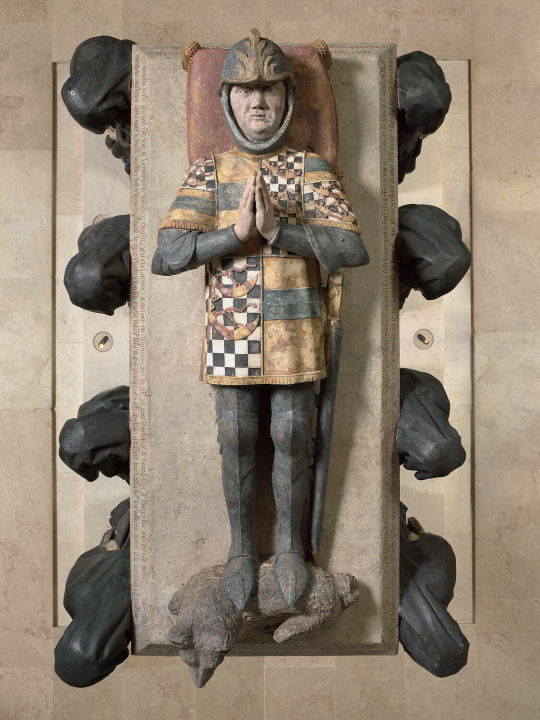

The animal at the feet of the effigy was poorly restored by prior generations resulting in loss of some detail. Historians disagree on whether it was meant to represent a lion or a dog but many see it as a dog, a popular symbol of loyalty in Burgundian tomb art.
I think I'll call him Luther.

Further reading: The Order of the Golden Fleece
Another organization founded in the late Middle Ages, but not a monastic order like the Templars. This order still exists today in two separate branches. The Spanish order has become an order of merit of the state, while the Austrian order has remained a Catholic chivalric order and is recognised even by the Republic of Austria as an international legal entity. Considered to be a highly prestigious honor even today.
My research has dredged up no particular historical association between this order and anything involving Templars or Freemasons other than the mere fact that both the Templars and the Golden Fleece were knightly organizations. I also find no connection between Philippe Pot and the Templars. Based on that, I think the photo of this tomb was included purely for the aesthetics--the medieval character, the heraldic shields, the effigy of a knight are all meant to evoke the idea of Templars without actually being tied to them.
[Nigel's Book Details: Spread One] [Nigel's Book Details: Spread Two] [Like Minds Masterpost]
#due to difficulty identifying some images i am choosing to proceed with the spreads I CAN do rather than#try to complete each spread in order#basically: spread 3 is giving me fits so we're moving on for now#like minds#nigel colbie#alex forbes#tom sturridge#murderous intent#like minds 2006#like minds analysis#like minds annotations
33 notes
·
View notes
Text
Guillaume Dufay (c. 1400 - 1474)
— Magnanime gentes laudes / Nexus amicie Musa — Moribus et genere / Virgo, virga virens — Fulgens iubar ecclesiae dei / Puerpera, pura parens
[MS {alpha}.X.1.11 (Modena B; ModB) Biblioteca Estense, Modena, Italy]
— Magnanime gentes laudes / Nexus amicie Musa
CANTUS Magnanimae gentis laudes patiare, Minerva, Augeat usque suum nuntia fama decus. Vox Pegasea locum mundi percurrat ad omnem: Cognoscant Dachus, Teucria, Parthus, Arabs, Quam fortes animos, quam ferrea pectora quamque Egregios sensus, optima Berna paris. Viribus armorum cuius res publica florens Consilio veterum multiplicata manet. Cultrix iustitiae, communis pacis amatrix, Quae tua gloria sit, maxima Gesta docent. Alleluia, alleluia.
CONTRATENOR Nexus amicitiae Musa modulantem Camoenam Magnificetur, enim nil sine pace valet. O quando iungi potuisti, Berna, Friburgo, Quanta mali rabies impetuosa ruit! Optima cum vobis communia vota fuere, O quibus, o quantis utraque functa fuit! Vivite felices! praeclara Sabaudia pacis Auctrix, servatrix foedera vestra probat. Praegenitum Ludovicum comitemque Philippum Cernitis: en magnum pondum amicitiae! Alleluia, alleluia.
TENOR Haec est vera fraternitas
— Moribus et genere / Virgo, virga virens
CANTUS Moribus et genere Christo coniuncti Iohannes, Huc ades affluerque iube dictaminis amnes. Excercet plebs ista choros tibi, carmina pangit, Angelicos tangit coetus cantando decoros.
Carne viror, sed mente rubor, sunt haec tibi dotes, Corde nitor, sermone decor, caeli scala pontes. Virginitate fruens, niveo candore notate, Te laudant olei profuse corpore guttae.
CONTRATENOR Virgo, virga virens, vires virtutibus affer Arteriisque pluens cantorum guttura profer, Ut bene coniuncti concordi voce canentes Astra sonent caelique boent hoc nectare fontes.
Pectora, Christe, tua nimio veneranda decore Discipuli pectus tetigit pietatis honore; Pectore discipulus domini caenando Iohannes Incubat et lenes dulcis sopor occupat artus.
Circumfulsit eum rerum cognitio clara Ut Patris hic filium cognovit origine mira. Ecstasis haec felix, haec visio certe beata, Qua nexus cuiusque patet cognitio tanta.
Gaudeat ecclesia, laetetur chorus et omnes Laetentur populi per climata cuncta beandi; Divio, divitiis nunc afflue, Divio dives, Huius et obsequiis plus donativatque vives. Amen.
TENOR Virgo est electus a domino.
— Fulgens iubar ecclesiae dei / Puerpera, pura parens
CANTUS Fulgens iubar ecclesiae dei, Peccatorum salus promptissima, Si precibus quibuscumque flecti Queas, nobis da, virgo beata, Ut omnes qui tuae mysteria Purificationis colimus Post temporis huius curricula Sublimemur sanctorum sedibus.
Quae semine viri peperisset, Mulierem lex quondam cogebat, Ut ad templum purganda veniret Partum ferens; lex haec non urge bat Mariam, quae virum non noverat. Illa tamen pro nobis omnibus Legem tulit, ut nos quos amabat Sublimemur sanctorum sedibus.
Quod purgari non indignaverit Huius festo monstrat ecclesia Per cereum, quem tunc quisque gerit Luce enim qua fulget candela Per splendorem vitae in Maria Concorditer omnes ostendimus, Ut per sua tandem precamina Sublimemur sanctorum sedibus.
O igitur virtutis exemplar, Virginum lux, gloriosa virgo, Decus nostrum et, ut verum loquar, Viva virtus, pulchra pulchritudo, Sanctitatis excellens ymago, Humiliter a te requirimus, Ut post mortem cum dulci gaudio Sublimemur sanctorum sedibus.
CONTRATENOR Puerpera, pura parens, Enixa regem saeculi, Tibi non fit orba parens Ritu mens: vales saeculi Vitam reddere, nonnulli Salvati sunt hoc limite; Das haec merito tituli: “Fili, peccata remitte!
Eia, virgo lapsu carens, Charta qua Ditem expuli, Annuisti legi verens Solvere legem; et pulli Turturum tis infantuli Exmonstrant oblati vitae Lucem; prome quod intuli: “Fili, peccata remitte!”
Larga mater, lux oriens Omen dedit opusculi, Cum Simeon non moriens Amplexatur hunc: “oculi Numen vident” et servuli Tenore dat verbum: “mitte!” Ad Christum dic: “te protuli: Fili, peccata remitte!”
O igitur virgo clemens, Quae nos omnes redemisti, Domus dei, gemma fulgens, Dulci porta paradisi, Dic nunc, quaeso, tuae proli, Quem lactasti tuo lacte, “Istis qui serviunt tibi, Fili, peccata remitte!”
TENOR Virgo post partum quem genuit adoravit.
_ O Gemma Lux Huelgas Ensemble ~ Paul Van Nevel (2000, Harmonia Mundi – HMC 901700 )
33 notes
·
View notes
Photo

🦖 Description des mollusques fossiles qui se trouvent dans les grès verts des environs de Genève /. Genève: impr. de Jules-Guillaume Fick, 1847-1853.. Original source Image description: Historical illustration depicting various fossilized mollusk shells from the Cretaceous period near Geneva. The image features detailed, black-and-white lithographic drawings of multiple bivalve species, including Astarte gurgitis, Crassatella Saxoneti, C. Sabaudiana, C. Fisiana, Cardita Constantii, and C. rotundata. Each shell is shown from different angles, highlighting distinct shapes, ridges, grooves, and hinge structures. The shells vary in form from rounded to elongated, with textured surfaces illustrating fine striations and anatomical features relevant to paleontological classification. The plate is labeled "Pl. 33" and includes scale bars for size reference.
25 notes
·
View notes
Text
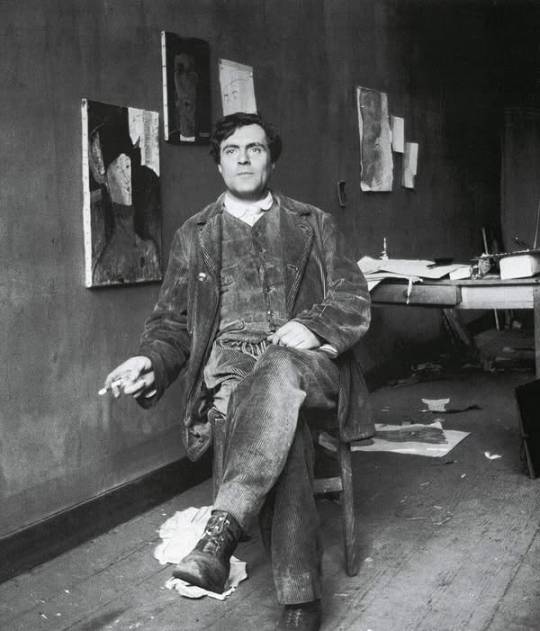
Ph Paul Guillaume - Amedeo Modigliani in his studio, c. 1915
26 notes
·
View notes
Text


TEMPLAR BOAR WITH CAMELINE SAUCE (14th c.)
This past Thursday, the Corpus Christi public holiday in my part of Germany, known here as Fronleichnam, gave me a little extra time to make another Tasting History dish: Templar Boar with Cameline Sauce. The diet, eating habits, and table manners of the Templars were governed by strict rules, including only eating meat three times a week (two meat meals on Sundays). This dish was one of those they would have eaten for one of their meat meals during the 14th century. The spices present in the sauce would have been accessible to them during the crusades, but Cameline Sauce did become a popular dish in much of medieval Europe eventually. This dish is based on two 14th century primary sources: Le Viandier de Taillevent by Guillaume Tirel and Le Ménagier de Paris, a treatise written by an older man (as yet unnamed) to teach his 15-year-old bride how to run his household and please him, in every way (...yikes). The sauce, Cameline, is named as such due to the rich brown colour, which looks like the wool of a camel, also known as cameline. I chose to make this recipe next because I haven't made boar before, and the rich, silky, brown colour of the sauce made it look really tasty. See Max’s video on how to make it here or see the ingredients and process at the end of this post, sourced from his website.
My experience making it:
I made a couple changes to the modern recipe below. I used boar goulash pieces instead of tenderloin, because it was the only form of boar I could find at my grocery store. The white wine I used (and drank with dinner) was a dry Riesling from the Mosel Valley in Germany. The red wine was a Bordeaux Merlot. I used saffron powder instead of threads, and I did opt to add the optional tablespoon of red wine vinegar. the white bread I used was a classic French baguette.
I also made a couple changes to the method. Because I used French baguette, which has quite small slices, I hollowed out about half the baguette (since baguettes are mostly crust). I also simmered the sauce for much longer than Max says to, because it wasn't quite the thickness I was looking for. Otherwise, I followed Max's recipe exactly, probably to the detriment of my boar. Because I had used goulash pieces instead of tenderloin, I probably should have adjusted how I cooked the boar to accommodate these smaller pieces. Unfortunately, I didn't, and as a result, I was left with very chewy, dry boar. Basically, the sauce was the saving grace of the boar! I served the boar and Cameline sauce with some green peas, garlic bread, and a glass of the dry Riesling wine.
My experience tasting it:
I already knew I had ruined the texture of the boar, but I hoped that the sauce would help. I warned my husband. Luckily, the Cameline sauce did a lot of heavy-lifting to bring some moisture back to the board. The sauce turned out wonderfully - a beautiful, silky brown. Flavour-wise, it reminded me of a jus, but more heavily-spiced. I was worried the Cameline sauce would end up tasting sweet due to the brown sugar and several spices that are more often used in baking, but in fact, the spices were well balanced by the taste of the wine and vinegar. The sauce also went really nicely with the peas, and I imagine would also have tasted good with potatoes or other red meats. My husband and I dipped the garlic bread in it as well, which was really tasty. It went alright with the dry boar, but I would like to use the sauce with another, more tenderly-cooked meat. We had leftover Cameline sauce, so we will probably try that again tonight. If you end up making it, if you liked it, or if you changed anything from the original recipe, do let me know!
Links to harder-to-find ingredients:
Saffron
Templar Boar with Cameline Sauce original recipes (14th c.)
Sourced from Le Viandier de Taillevent by Guillaume Tirel and Le Ménagier de Paris respectively.
“Sanglier: Fresh Wild Boar Venison. Cooked in wine and water and boiled again; eaten with Cameline Sauce.”
— Le Viandier de Taillevent, 14th century
“Cameline. Note that in Tournai, to make cameline they grind ginger, cinnamon, saffron, and half a nutmeg, moistened with wine then taken out of the mortar. Then grind in a mortar untoasted white breadcrumbs that have been soaked in cold water, moisten with wine and strain. Then boil everything and finish with brown sugar, and that makes winter cameline. In the summer, they do the same but it is not boiled at all. ”
— Le Ménagier de Paris, 14th century
Modern Recipe
Based on Le Viandier de Taillevent by Guillaume Tirel, Le Ménagier de Paris, and Max Miller’s version in his Tasting History video.
Ingredients:
Boar tenderloin
Olive oil for searing
Equal parts wine and water for boiling
1 thick slice of white artisanal bread without crust
1 ¼ cups white wine
¼ cup red wine
1 tsp ginger
2 tsp cinnamon
½ tsp nutmeg
Pinch of saffron threads
2 tbsp brown sugar
Pinch of salt
1 tbsp red wine vinegar (optional)
Method:
De-crust the bread and break it into small pieces. Soak the bread in water for a few hours, then pour in the red wine for the sauce.
Heat olive oil in a pot then sear the boar on all sides.
Remove it from the pot and boil equal parts wine and water, then add the boar back in and boil, covered, for 10-15 minutes or until fully cooked. Then let it rest.
To make the sauce, mix the spices and white wine. Strain the bread/wine mixture from earlier into a saucepan, then press the bread through the strainer.
Add the spiced wine mixture and bring to a simmer. Let simmer for 15 minutes, or until half reduced, then add the sugar and salt, and if you want, a tablespoon of red wine vinegar. Simmer until thickened.
Slice the boar and pour the sauce over it. Optionally, serve with roasted chestnuts and wine.
#14th century#max miller#tasting history#cooking#tasting history with max miller#keepers#medieval meals#boar#french recipes#europe#Templar#crusades#Cameline Sauce#Sauces#meat#Le Viandier de Taillevent#Le Menagier de Paris#Guillaume Tirel#Europe#France
83 notes
·
View notes
Text

"Cyparissus on the body of his deer", c.1825 by Sébastien-Louis-Guillaume Norblin de la Gourdaine (1796-1884). French painter. oil on canvas
272 notes
·
View notes
Text
Electronic devices rely on materials whose electrical properties change with temperature, making them less stable in extreme conditions. A discovery by McGill University researchers that challenges conventional wisdom in physics suggests that bismuth, a metal, could serve as the foundation for highly stable electronic components. The researchers observed a mysterious electrical effect in ultra-thin bismuth that remains unchanged across a wide temperature range, from near absolute zero (-273°C) to room temperature. "If we can harness this, it could become important for green electronics," said Guillaume Gervais, a professor of physics at McGill and co-author of the study. The finding could lead to the development of more efficient, stable and environmentally friendly electronic components and devices, including for space exploration and medical uses. Bismuth is non-toxic and biocompatible.
Read more.
12 notes
·
View notes